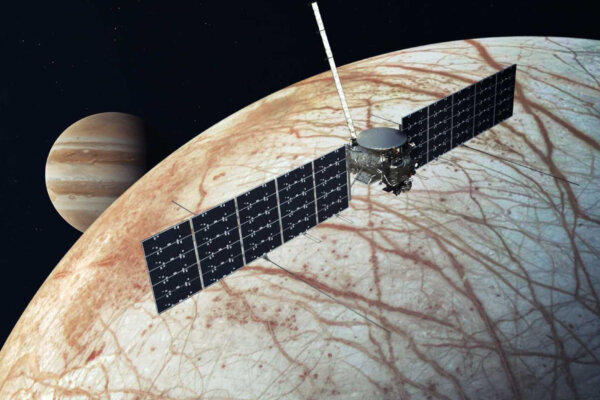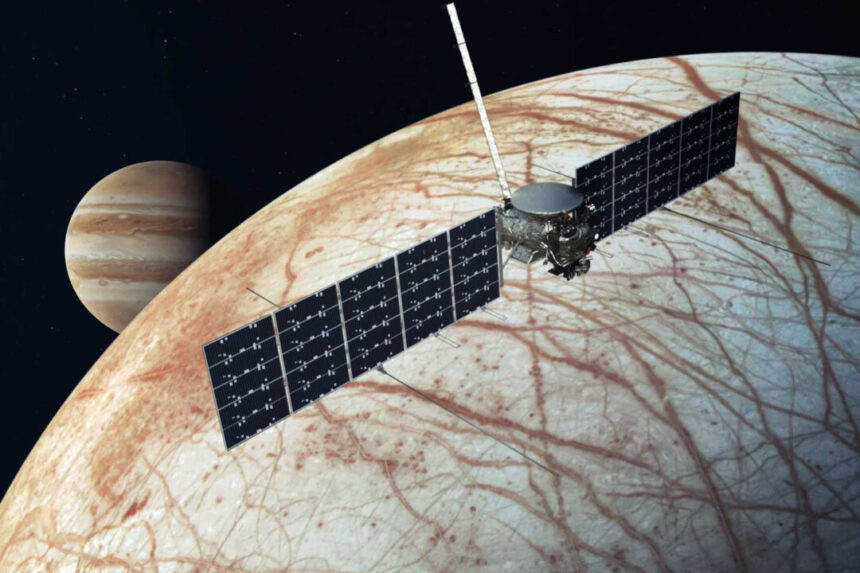
A NASA spacecraft is prepared to embark on a journey to Jupiter and its moon Europa, one of the most promising locations for discovering life beyond Earth.
The Europa Clipper mission aims to explore beneath the icy surface of the moon to investigate the potential presence of an ocean close to the surface. While the mission will not directly search for life, it will assess whether the conditions on Europa could support life. Further missions would be required to investigate any potential microorganisms in the area.
Program scientist Curt Niebur expressed excitement about the opportunity to explore a world that may be habitable in the present day. Europa Clipper is the largest spacecraft built by NASA for planetary exploration, featuring massive solar panels. The spacecraft is set to reach Jupiter in 5 1/2 years and will approach within 16 miles of Europa’s surface, closer than any previous spacecraft.
The launch is scheduled for this month aboard SpaceX’s Falcon Heavy rocket from NASA’s Kennedy Space Center, with a mission cost of $5.2 billion.
Europa: A standout moon of Jupiter
Europa is one of Jupiter’s 95 known moons and is nearly the size of Earth’s moon. Covered by an estimated 10 to 15 miles thick ice sheet, Europa is believed to conceal an ocean possibly 80 miles deep. The Hubble Space Telescope has observed potential geysers on Europa’s surface. Discovered by Galileo in 1610, Europa is one of Jupiter’s Galilean moons, along with Ganymede, Io, and Callisto.
Exploring Habitability on Europa
Scientists speculate about the potential life on Europa, considering the presence of water, organic compounds, and an energy source like thermal vents on the ocean floor. Deputy project scientist Bonnie Buratti envisions primitive life forms similar to bacterial life found in Earth’s deep ocean vents. Clipper’s primary objective is to determine whether Europa’s ocean or any water pockets in the ice could support life.
Features of the Europa Clipper
Once its solar wings and antennas are deployed, Clipper spans over 100 feet and weighs nearly 13,000 pounds. The spacecraft is equipped with nine science instruments, including radar to penetrate the ice, cameras for mapping the moon, and tools to analyze Europa’s surface and atmosphere.
Mission to Jupiter and Europa
The journey to Jupiter will cover 1.8 billion miles. Clipper will swing past Mars and Earth for additional momentum before reaching Jupiter in 2030. The spacecraft will conduct flybys of Europa 49 times while orbiting Jupiter, with the mission concluding in 2034 with a planned crash into Ganymede.
Radiation Challenges and Potential Discoveries
Jupiter’s radiation poses a significant risk to spacecraft, but Clipper’s design includes protective measures to withstand the intense radiation. While surface life on Europa is unlikely due to radiation, the mission aims to explore the potential for oxygen release into the ocean, which could support sea life.
Previous Missions and Future Exploration
Several spacecraft, including Pioneer, Voyager, Galileo, and Juno, have provided insights into Jupiter and Europa. The European Space Agency’s Juice spacecraft is also set to arrive at Jupiter after Clipper. Ganymede and other moons in our solar system, like Callisto and Enceladus, are believed to have underground oceans, hinting at the possibility of life beyond Earth.
Messages from Earth
Similar to previous missions, Clipper carries messages from Earth, including a design representing the word “water” in 104 languages and a poem by U.S. poet laureate Ada Limon. The spacecraft also holds a silicon chip containing the names of 2.6 million individuals who signed up to be part of the mission.
By Marcia Dunn





